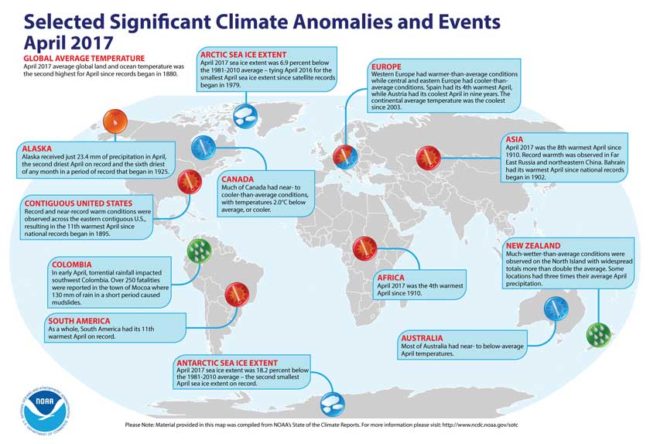
In Summary …
Temperature
The combined global average temperature over the land and ocean surfaces for April 2017 was 0.90°C (1.62°F) above the 20th century average of 13.7°C (56.7°F)—the second highest April temperature since global records began in 1880, trailing 2016 by 0.17°C (0.31°F) and ahead of 2010 by 0.0.7°C (0.13°F). April 2017 also marks the 388th consecutive month that the globally-averaged temperature across the world’s land and ocean surfaces was nominally above the 20th century average.
Precipitation
As is typical, precipitation anomalies during April 2017 varied significantly around the world. April 2017 precipitation was generally drier than normal across Alaska, the southwestern contiguous U.S., Mexico, northeastern Brazil, southwestern and northern Europe, Australia, and scattered across southern, central, and eastern Asia. Wetter-than-normal conditions were notable across the eastern half of the contiguous U.S., southern South America, eastern Europe, and across northern and southeastern Asia.
Sea Ice Extent (via NSIDC)
Arctic
According to the National Snow and Ice Data Center (NSIDC), the Northern Hemisphere (Arctic) sea ice extent — which is measured from passive microwave instruments onboard NOAA satellites — averaged for April 2017 was 13.83 million square km (5.34 million square miles), 1.02 million square km (390,000 square miles), or 6.87 percent, below the 1981-2010 average. This tied April 2017 was the smallest April Arctic sea ice extent on record. This is the seventh consecutive month with record-low sea ice extent in the Arctic.
Antarctic
The April Southern Hemisphere sea ice extent was 6.07 million square km (2.34 million square miles), which was 1.35 million square km (520,000 square miles), or 18.19 percent, below the 1981-2010 average. This was the second smallest April Southern Hemisphere sea ice extenton record and 140,000 square km (50,000 square miles) larger than the record set in 1980.
Trends
One month in isolation is of course not the whole story, it is the overall trend that yields the unfolding saga. here is a chart illustrating the Global Temperature Anomalies for each and every April since the start of precise measurements in 1880 …
There is nothing magical about April here. If you look across the same timescale for any month, or for all months, it tells us exactly the same story. The April that just passed is also not record breaking, but it is clearly part of the on-going trend.
In summary: should we continue to be worried?
Basically yes.
Tweets
#Arctic #SeaIce extent tied for smallest on record in #April —@NOAANCEIclimate https://t.co/BLeu9xVIZt #StateOfClimate pic.twitter.com/LnVElxiZOj
— NOAA (@NOAA) May 18, 2017
January–April 2017 was 2nd warmest first 4 months of the year for the globe: @NOAANCEIclimate https://t.co/BLeu9xVIZt #StateOfClimate pic.twitter.com/6CAg1ToiZ4
— NOAA (@NOAA) May 18, 2017